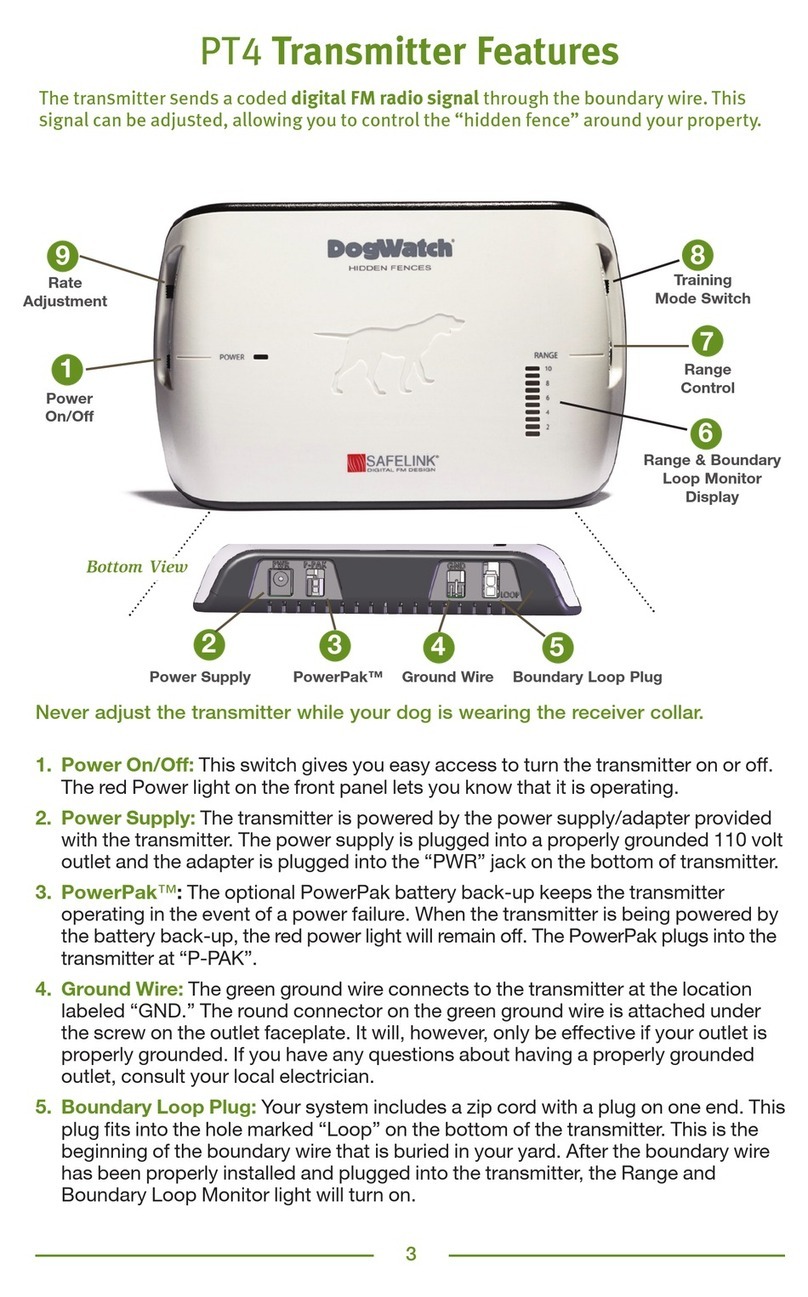3
Troubleshooting
Training
■Establish your boundary area(s) and mark the edge of the Audible Warning Zone with flags just past where
the receiver collar picks up the audible signal. The boundary flags serve as visual clues for your pet while he
learns which areas are safe and which areas to avoid.
■Put the receiver collar on your pet making sure it is adjusted appropriately. It should be snug with the
contact posts touching the skin but not uncomfortably tight.
■Attach a leash to your pet’s regular collar and approach the signal field. As you near the flags shake a
boundary flag in front of him and firmly say “Watch out!” or “Careful!”
■Allow your pet to walk past the boundary flags. As he crosses into the audible warning area he will hear a
beeping noise. If your pet has already been trained to an outdoor Hidden Fence he may retreat immediately
when he sees the flags or hears the beeps. If he continues into the correction zone he will receive a brief
‘correction’ (a mild sensation that is unpleasant but will not harm your pet.) Immediately call out “Watch
out” and tug the leash firmly to pull your pet out of the signal field.
■Again allow your pet to approach the boundary flags. If he retreats when he hears the audible warning
reinforce the behavior with praise and affection. If your pet fails to stop at the audible warning repeat the
above. You may need to repeat this several times over several days. Allow for plenty of rest and play time.
■Each time you set up a new boundary area be sure to retrain your pet to the new boundary area.
If your pet enters the avoidance area without responding to the correction signal make sure that both the
transmitter and the receiver collar are “on” and working. If both the transmitter and the receiver are functioning
properly you may need to increase the signal range on the transmitter or the correction level on the collar.
Reminder:
Never adjust the transmitter while your pet is wearing the receiver collar.
■Check to make sure the transmitter is plugged in wall switches are turned on and the power light is on.
■Check the receiver by placing the test light on the contact posts while holding the receiver next to your
wireless transmitter. Avoid touching the posts. If your test light lights up your receiver is working properly.
■Ensure that the collar fits and the contact posts on the receiver collar actually touch your pet’s skin.
■Be sure the receiver battery is inserted correctly. Replace the battery if necessary.
Smaller
Signal Field
Larger
Signal Field
Twisted wire
completes the signal loop)
The boundary wire supplied with the transmitter is a double wire designed to be separated in the areas where
you want to create a signal field (the avoidance area). When the two wires are next to one another there is no
signal field.
TThhee ssiiggnnaall ffiieelldd iiss ccrreeaatteedd bbyy sseeppaarraattiinngg tthhee wwiirreess..
Separating the wires increases the size of the
signal field as well as the signal range (the distance the signal travels from the wire). A signal field may be
created in a single location or multiple locations on the wire.
The boundary wire must form a continuous signal loop for
there to be a signal field. To accomplish this you must strip
and twist the final ends of the boundary wire together.
The Power Status light turns “off” if you have not closed the
signal loop or if the wire is bro en.
The boundary wire carries a harmless radio signal. You do not
need to worry about an electrical shock from the wires.






















